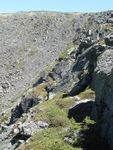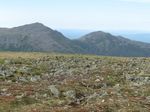American Pipit (Anthus rubescens) Surveys on Mount Washington, June 2018 through August 2020
←
→
Page content transcription
If your browser does not render page correctly, please read the page content below
Page |1
Great Gulf Wilderness headwall with Mt. Washington (r) and other Presidential Range peaks (l) in July 2018. Sheridan Brown photo.
American Pipit (Anthus rubescens) Surveys on Mount Washington,
June 2018 through August 2020
Final Report to the Robert F. Schumann Foundation
Territorial American Pipit in ‘Cow Pasture’ on Mt. Washington in June 2020. David Govatski photo.
Principal Investigator:
Christian J. Martin
NH Audubon, 84 Silk Farm Road, Concord, NH 03301
(603) 224-9909, x317 or cmartin@nhaudubon.orgPage |2 Background The American Pipit (Anthus rubescens) is a “Special Concern” bird species in New Hampshire, a conservation category that suggests the state’s pipit breeding population could potentially decline enough to warrant reclassification to “State-Threatened” status, if appropriate management steps to safeguard these birds, and their limited breeding habitat in New Hampshire, do not occur. The fact that pipits have an extremely limited breeding distribution in the state also prompted New Hampshire Fish and Game to list pipits as a “Species of Greatest Conservation Need” (SGCN) in the New Hampshire 2015 Wildlife Action Plan (NH Fish and Game Department 2015). SGCN species are those which are in serious jeopardy, often demonstrating declining numbers with smaller patches of suitable habitat and/or threatened by a host of management issues. The Audubon Society of New Hampshire (NH Audubon) has been monitoring pipits breeding on Mount Washington (elev. 6,288 ft.) on an intermittent basis since the mid-1990s. In 1997, NH Audubon field technicians surveyed pipit presence along 20 miles of alpine trail transects in the Presidential Range, but at that time found pipits breeding only on Mount Washington. In 1998, an NH Audubon field team conducted a more intensive study of the breeding population that focused solely on Mount Washington (see NH Audubon Nov-Dec 1998). During the 1998 field season, we located 11 pipit breeding territories, >21 adult pipits, 8 active pipit nests with >43 eggs, and later in the season we tallied >27 fledged young. We found that all known pipit nests were confined to a narrow band of alpine habitat located from 5,200 to 5,800 ft. Our work in the 1990s was supported by the U.S. Forest Service, the NH Audubon Wildlife Challenge Fund, and grants from both the Rivendell Foundation and the Wild Wings Foundation. Nearly 20 years later, in 2017, with support provided by The Waterman Fund and the Nuttall Ornithological Club’s Charles Blake Fund, we re-surveyed alpine habitat across the Presidential Range and Franconia Ridge in preparation for doing an updated pipit breeding study. We covered 13.8 miles of alpine trail transects, once again finding pipit display flights and fledglings only on Mount Washington itself, despite the fact that the majority of our survey miles were not located on Mount Washington (see Martin and Galbraith 2018). Current Project (2018-2020) funded by Robert F. Schumann Foundation With evidence that breeding pipits still remained largely confined to the summit of Mount Washington, the highest alpine habitat in the Presidential Range, we received support from the Robert F. Schumann Foundation for what we envisioned as an intensive multi-year field project to examine the breeding ecology of American Pipits on Mount Washington. In June-July 2018, we conducted Year 1 of this American Pipit breeding survey on Mount Washington. Methods: We focused our fieldwork on areas of Mount Washington above 5,000 ft (Figure 1). Selecting days without fog and low wind speeds
Page |3
Figure 1. American Pipit survey area (yellow) on Mt. Washington summit showing 5,000-foot contour (dashed lines).
Results: Weather on the summit of Mount Washington always presents major challenges for those
attempting to conduct fieldwork in this environment. In June-July 2018, we managed to get pipit survey field
crews out on five days (June 3, 20, and 22; July 11 and 20) for a total of 25.5 hours spent conducting pipit field
surveys. During those surveys, we walked a total distance of 11.75 mi of trail transects above 5,000 ft. We
observed 11 flight display areas and saw many pipits foraging, but to our disappointment, we did not locatePage |4
even one nest during those five field days. We documented sightings of 26 adults and five young-of-the-year
pipits during surveys, including >16 adult pipits prior to July 11, and a total of 10 adults plus five fledged
juveniles on July 11 and 20. Pipit flight displays originated in areas from 5,525-6,150 ft elevation (mean = 5,820
ft, median = 5,775 ft, N = 11). Aspect of terrain in areas where flight displays originated was not random. In
fact, all locations faced in an arc from west-northwest to northeast (mean = 310 degrees, median = 30
degrees, N = 11). Figure 2 below indicates where key activities were observed in 2018.
Figure 2. Locations where adult male flight displays (D) and adults feeding young (FY) were detected in 2018 surveys.Page |5 In June-July 2019, we were unable to allocate sufficient staff/time to adequately complete fieldwork that we had planned to carry out. This failure was due primarily to limitations in our staffing capacity and scheduling conflicts with other conservation projects with June-July deadlines – both of which we should have anticipated – and to a lesser degree to less predictable issues related to the challenges of doing fieldwork on Mount Washington. Because we did not complete field tasks as planned in 2019, we still retained sufficient funds to plan for fieldwork in June-July 2020. Other birders not involved with our study reported their Mount Washington pipit sightings in June-August 2019 on eBird; David Govatski found two pipit pairs on June 9, and Sara Griesemer counted six pipits on August 2 and seven on August 3. When the COVID-19 pandemic shutdown developed beginning in March 2020, work plans and procedures were altered for NH Audubon’s field biologists, along with practically everyone else. However, despite significant restrictions, NH Audubon staff and volunteers were still able to conduct one thorough count in Mount Washington’s high-elevation pipit habitat. On one fair-weather day (June 18), we documented >11 adult pipits and several male pipit display flights in the Cow Pasture, near Ball Crag, adjacent to the 6,000-ft parking area, and along the Cog Railroad adjacent to the Great Gulf Headwall (Figure 3). Other birders reported their Mount Washington pipit sightings in June-August 2020 on eBird; Lauren Smith counted five pipits on June 27, Steven Daniel had one carrying food on July 19, and Nicholas Forestall tallied 10 pipits on August 24. Figure 3. Great Gulf Headwall (l) and Cow Pasture (r) were two areas with considerable pipit activity during our Mt. Washington surveys. Photos by Chris Martin. Conclusions: Despite chronic staffing issues, weather and other logistical challenges, and COVID-19 restrictions during 2020 – all of which limited the scope of our fieldwork – NH Audubon’s 2018-2020 data on American Pipit breeding activity on Mount Washington still offers some useful insights on the status of this
Page |6 isolated southernmost breeding population found in eastern North America. All pipit activity detected during our field surveys occurred in areas north of the summit and northwest of the Nelson Crag Trail from Nelson Crag to the summit cone. In particular, pipits were very active in the Cow Pasture (Auto Road Mile 6.5), at the 6,000 ft parking area (Auto Road Mile 7.3), near the former site of the fuel tanks and Nelson Crag Trail crossing (Auto Road Mile 7.5), and along the Cog Railway and edge of the Great Gulf as far as the saddle to Mount Clay. Trails on the eastern, southern, and western sides of the summit cone, from Alpine Garden to Bigelow Lawn to Westside Trail, appear to be less favored, and had little to no pipit activity documented (Figure 4). Figure 4. Areas where little pipit activity was detected included Crawford Path and Bigelow Lawn. Photos by Chris Martin. Pipits are ground-nesting at a higher elevation than any other bird species found in New England, and their Mount Washington population appears to have remained fairly stable over the past 20+ years. Pipits appear to be able to cope with harsh weather, predation risks (including from Common Ravens patrolling overhead, and from predatory mammals including weasels, shrews, and even Red Squirrels (the latter we observed traversing the treeless ‘Cow Pasture’ during our fieldwork), and potential for collisions with vehicles travelling on the Auto Road, and even potential encounters with Cog Railway trains (Figure 5). It is less clear whether they will be able to cope with encroachment of shrubby vegetation and patches of krummholtz trees as the climate continues to warm over the coming decades. Combined with surveys conducted in 2017 (Martin and Galbraith 2018), which failed to detect presence of pipits during the breeding season on other Presidential peaks and on Franconia Ridge, we conclude that in the White Mountains American Pipit breeding continues to be restricted to a relatively small patch of the highest alpine habitat in the state near the summit of Mount Washington. At this time, it appears that the nearby peaks of the Presidential Range and Franconia Ridge are harboring few, if any, additional pipit breeding pairs.
Page |7
Figure 5. Cog Railway train crossing American Pipit breeding habitat at 5,600 ft near the Skyline Switch. Chris Martin photo.
References cited:
eBird Mount Washington hotspot ( https://ebird.org/hotspot/L295828).
Martin, C.J. and H. Galbraith. 2018. 2017 survey of the American Pipit (Anthus rubescens) breeding population
in alpine habitat in New Hampshire’s Presidential Range and Franconia Ridge. Final report to The Waterman
Fund. 6 pp.
NH Audubon Nov-Dec 1998. Stalking the Wild American Pipit. Article written by Chris Martin. NH Audubon
newsletter 34(6): 5-6, and 14.
NH Fish and Game Department. 2015. New Hampshire Wildlife Action Plan (revised).
Acknowledgments: NH Audubon appreciates the financial support provided by the Robert F. Schumann
Foundation and by additional support from the Nuttall Ornithological Club’s Charles Blake Fund. We also thank
wish to acknowledge Sheridan Brown, David Govatski, and Wink Lees for their much-appreciated field
assistance.
~ ~ ~
The Audubon Society of New Hampshire (a.k.a. NH Audubon) is a statewide nonprofit membership organization dedicated to the
conservation of wildlife and habitat throughout the state. Founded in 1914 and independent of the National Audubon Society, NH
Audubon programs focus on wildlife conservation, land protection, environmental policy, and environmental education. Our mission
is to protect New Hampshire's natural environment for wildlife and for people. We often collaborate with other nonprofits, state and
federal agencies, municipalities, and industry to accomplish this goal, respecting partners’ perspectives while advocating for the best
possible environmental outcomes. Our Conservation Biology staff work to gather information about species in peril and take steps to
protect them. We have led efforts to restore threatened or endangered terns, Bald Eagles, Peregrine Falcons, Ospreys, and Northern
Harriers in collaboration with state agencies and other organizations. We also played a lead role in developing and revising the NH
Fish and Game Department’s 2015 NH Wildlife Action Plan, which identifies key issues facing all birds, and what types of research,
monitoring, or management is most critically needed.You can also read


























































